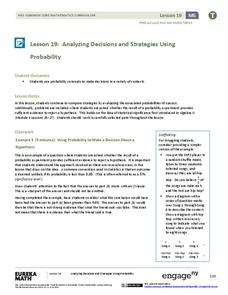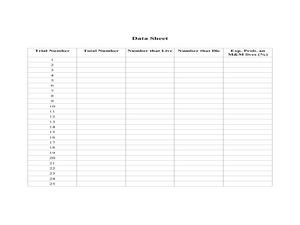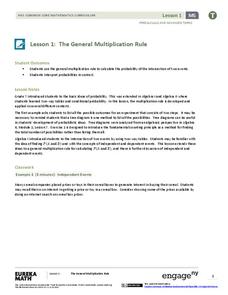Curated OER
The Probability of (Not A)
In this statistics and probability worksheet, students determine the probability of an event not occurring. The one page worksheet contains four problems. Answers are provided.
Curated OER
Data Analysis and Probability
Students design models to simulate actual events using various random devices. They estimate the likelihood of a particular outcome using results of simulation. In addition, they simulate the births of three children to a using a coin.
Curated OER
Integrate Algebra Regents Exam Bimodal Questions Worksheet #1
In this Integrated Algebra learning exercise, students solve problems that reflect the topics covered during the course of work. The answer key identifies each question by standard and topic. The twenty-four page...
Curated OER
Probability
Ninth graders engage in a lesson that is about the concept of probability using the context of recording data and predicting outcomes. They collect marbles while recording data and graphing it. The graph is analyzed and ideas are...
Curated OER
Basic Probability
Students explore basic probability. In this Algebra II/Geometry lesson plan, students use modeling to solve basic probability problems involving real-life applications.
Curated OER
Probability of an Event Occurring
In this probability worksheet, students calculate the chance of an event occurring. They solve word problems using probability. There are 3 questions with an answer key.
Curated OER
Probability
In the probability and statistics worksheet, high schoolers determine the probability of an event occurring. The one page worksheet contains one multiple choice question with the solution.
Curated OER
From Probability to Combinatorics and Number Theory
Middle schoolers see how division is used to help solve probability problems. They use tables as data structures where they are used to count outcomes and to compute probabilities. Students use games to help solve probability problems.
EngageNY
Analyzing Decisions and Strategies Using Probability 2
Explore how to compare and analyze different strategies. In the 20th installment of a 21-part module, scholars continue their analysis of decisions and strategies from the previous lesson. They then extend this concept to hypothesis...
Curated OER
Adding and Subtracting Algebraic Expressions (Combining Like Terms)
Everyone loves math when it includes food! This lesson tries to take the notion of combining like terms in algebra and comparing it to sorting apples and oranges. It takes a step-by-step approach to helping students understand this...
EngageNY
Events and Venn Diagrams
Time for statistics and learning to overlap! Learners examine Venn Diagrams as a means to organize data. They then use the diagrams to calculate simple and compound probabilities.
Math Stars
Math Stars: a Problem-Solving Newsletter Grade 7
Put on your thinking caps because middle school math has never been more interesting in this huge resource full of thought provoking questions. Written as a newsletter, the resource has 10 two-page newsletters with a variety of...
Curated OER
Probability
In this Algebra II worksheet, 11th graders compare and contrast experimental probability and theoretical probability. The two page worksheet contains explanation of topic, worked examples, and seven practice problems. Answers are...
Curated OER
Probability of Events Not Mutually Exclusive
In this algebra worksheet, students answer questions related to probability. They solve problems involving the probability of an even occurring, There are 5 questions with an answer key.
Curated OER
Empirical Probability
In this algebra worksheet, students identify the probability of something happening. They use empirical probability to solve problems. There are 5 questions with an answer key.
Curated OER
Discovering Advanced Algebra More Practice Your Skills, Lessons 11.1-11.6
In this six page series of activity, students answer short answer questions about a variety of topics. The six topics covered in this packet are: Experimental Design (4 questions), Probability Distributions (3 multiple choice questions),...
Curated OER
Advanced Algebra: Do You Feel Lucky?
Students explore the realm of mathematical probability while playing a game of chance. after constructing paper rockets, they fire it enough times to determine the probabilities of the rocket traveling past a marked distance and of it...
Curated OER
RIP M&M's
Learners solve theoretical probability problems. In this algebra lesson, students apply the concept of probabilities to solving real life scenarios. They collect data and graph it using experimental probability.
Curated OER
The Monty Hall Problem
Young scholars define and differentiate between experimental and theoretical probability. In this statistic instructional activity, students play the game "Monty Hall" and use probability to come up with the best strategies to play the...
Curated OER
Another Dartboard
Fifth graders solve a word problem that involves predicting probabilities of an event and making deductions from probabilities. They discuss dice and coins and the probability of rolling each number or face of the coin, and in small...
Alabama Learning Exchange
Pennies, Pennies and More Pennies
Learners determine the number of pennies needed to fill a room. In this pennies lesson plan, students work in groups to determine the number of pennies needed to fill a room. They compute the probability of the head of a pin...
Curated OER
Combinations and Permutations
In this statistics worksheet, students solve the probability of an event occurring using probability, permutation and combination. There are 17 questions with an answer key.
Curated OER
Lucky 7s
This helpful lesson explores the probability in tossing a coin and throwing dice. Specifically, it looks at the probability of getting numbers that are significant to the game of craps, assuming that once the math is understood, most...
EngageNY
The General Multiplication Rule
In the first installment of a 21-part module, scholars build on previous understandings of probability to develop the multiplication rule for independent and dependent events. They use the rule to solve contextual problems.

























